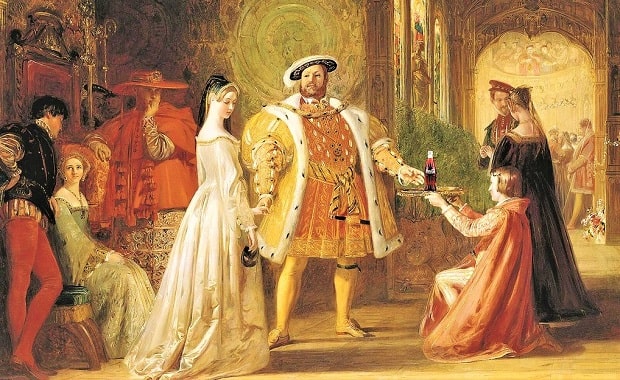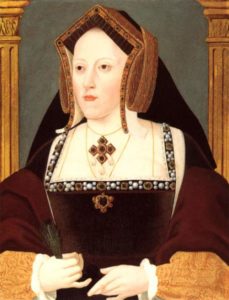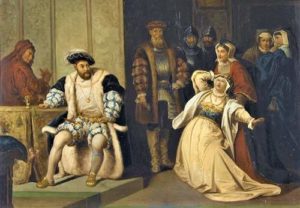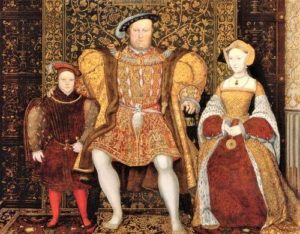
Henry VIII was born on June 28, 1491, in Placentia Palace (Greenwich, England). He was king of England and Ireland from 1509 until his death. He was the second of the Tudor dynasty. Son of Henry VII, the first English monarch of the Tudor dynasty, and Elizabeth of York. He broke with the Roman Church and founded the Church of England or Anglican.
The legal and theological controversy relating to the validity of her first marriage to Catherine of Aragon and its recognition of nullity was one of the main causes of the schism in 1534 of the Church of England with Rome and the English Reformation.
Henri VIII supervised this separation within particular the dissolution of the monasteries and was for that excommunicated; he nevertheless remained a defender of the fundamentals of Catholic theology. Henry VIII married six times and had two of his wives executed, Anne Boleyn and Catherine Howard.
Over the course of his marriages, he had removed from his estate his two oldest daughters Marie I and Elizabeth I in favor of his son Edward VI of England. All his legitimate children nevertheless ascended the throne but in the absence of descendants, his daughters were the last sovereigns of the Tudor dynasty.
Early Life Of Henry VIII
Henry VIII was born in the Palace of Placentia in 1491, Henri Tudor is the third child and the second son of King Henry VII of England and Elizabeth of York. Of Henri’s six siblings, only three (Arthur of Wales, Marguerite, and Marie) reach adulthood. After his father, Henry VII dies from tuberculosis on April 21, 1509, and the young Henri succeeds him under the name of Henry VIII.
He was baptized by the Bishop of Exeter Richard Fox in a Franciscan church not far from the palace. In 1493, at the age of two, he was made constable of the castle of Dover and governor of Cinque Ports. Henri received a very careful education, he spoke fluent English, Latin, and French and had some notions of Italian.
In 1509 after the death of Queen Elizabeth and King Henry VII, and Henry VIII occupied the throne for his late brother. Henry VIII was then 18 years old and a handsome young man who did not lack understanding or political ability. After girding the crown to replace her brother, she considered that for reasons of the state it was necessary to also replace him as a husband.
Getting rid of Catherine of Aragon and returning her to her country meant losing the large dowry contributed by her parents and, what was even more important, cutting a bond of inestimable value with the Spanish crown, more necessary than ever in the troubled European political context of back then.
The solution was to declare Catherine’s link with Arturo null. Catherine of Aragon herself admitted before an ecclesiastical court that the previous union had not been consummated due to the incapacity of the spouse and, therefore, she continued to be a maiden.
The Holy See had no problem granting the dispensation and, two months after ascending the throne, Henry VIII married Catherine of Aragon, five years his senior.
Henry VIII of England marriage to Catherine of Aragon
Since the sudden death of Arturo, Catherine of Aragon had remained confined in the Welsh fortress of Ludlow, given to prayers and mourning and waiting for what fate had in store for her. The long confinement had turned her into a matron of withered appearance and exaggerated devout customs. After her marriage to Henry VIII, she gave birth six times, but the only male born alive only nurtured for fifty-two days.
Henry VIII began to have interesting scruples of conscience and to consider that the origin of the curse was in the Bible: “You must not discover the nakedness of your brother’s wife,” says the Leviticus. His marriage to his sister-in-law, he thought, had not been valid, but sinful and forbidden; Catalina was cursed and she had to get rid of her. The international situation allowed the adoption of drastic measures.

The preponderance in Europe of the almighty Spanish sovereign Carlos V, Roman-Germanic emperor, and owner of half the world, induced Henry VIII to approach France to counter his strength. He could thus get rid of Catherine without losing allies, although it was not going to be easy to find a legal or apparently legal way to do it.
No less decisive than the lack of descendants and the European conjuncture was the entry on the scene of Anna Bolena, an English noblewoman who, after being educated in France, had returned in 1522 to the court as a lady of Queen Catherine.
Her attractiveness aroused passions between exalted figures, including Henry VIII himself, who tried to seduce her and hindered her marriage to Lord Henry Percy. But the ambitious Anna Bolena was not ready to become a mere lover; she wanted to be queen and, by means of a coldly calculated alternation of favors and disdain, she made Henry VIII fall madly in love with her.
Formation of the Anglican Church
Educated and intelligent, Henry VIII had shown from his youth his fervent Catholicism. He had used his brilliance against the Protestant reform launched by Luther in 1520, showing himself as an energetic defender of the Catholic faith. “Defender of the Faith” was exactly the title given by Pope Leo X by the Treaty of the Seven Sacraments, which the monarch had written in 1521.
But this situation would change as a result of the conflict unleashed with the Church due to the pressing succession problem: the marriage with Catherine of Aragon had not given him male heirs. In 1527, Henry VIII asked Pope Clement VII to annul the marriage on the pretext of prior kinship between the spouses.
The pope, under pressure from Charles V (who was Catherine’s nephew), denied the annulment, and Henry VIII decided to break with Rome, advised by Thomas Cranmer and Thomas Cromwell.
For this, Henry VIII of England was armed with arguments gathering from various European universities opinions favorable to his divorce (1529); and he took advantage of the prevailing discontent among the English secular clergy over the excessive papal taxation and the accumulation of wealth in the hands of the religious orders to make himself recognized head of the Church of England (1531).
In 1533, he had Thomas Cranmer (whom he had appointed archbishop of Canterbury) annul his first marriage and crown his mistress, Anne Boleyn, queen. Pope Clement VIII responded with the ex-communication of the king.
Henry VIII’s reaction was no less forceful: he passed in Parliament the Act of Supremacy (1534), by virtue of which the independence of the Anglican Church was declared and the king was elevated to its highest authority.
The Church of England was thus detached from the obedience of Rome and turned into an independent national Church whose head was the king himself, which would allow the Crown to expropriate and sell the heritage of the monasteries; English Catholics who remained faithful to Rome were persecuted as traitors; Its main exponent, the humanist Tomás Moro, author of Utopia, was executed in 1535.
However, Henry VIII did not allow the fundamental dogmas of Catholicism to be questioned; to avoid this, he issued the Act of the Six Articles (1539). Obviously, he could not prevent Cranmer from carrying out the reform of the Anglican Church, which definitively placed itself in the field of Protestant Christianity, with the introduction of Lutheran and Calvinist elements.
Divorce of Henry VIII of England and Catherine of Aragon
With the help of Thomas Cromwell, Archbishop of Canterbury, the highest ecclesiastical office in England, the divorce was carried out. The English Parliament declared that the king’s divine right replaced the authority of the Church. In 1531 he proclaimed the independence of the Anglican Church. Excommunicated by the Pope, Henry VIII proclaimed himself Supreme Head of the Church in England.

Together with his new chief minister, Thomas Cromwell, he dissolved the monasteries, increasing the total land of the Crown. The absolutism of the monarchy was definitely consolidated when it separated from the Catholic Church. The divorce of King Henry VIII and Catherine of Aragon marked the beginning of the English Reformation.
marriage to Anne Boleyn
Even though he had been excommunicated and was dissatisfied with himself and a victim of remorse, nothing prevented Henry VIII from enjoying the favors of Anna Bolena, who had been delivered with passion as soon as events began to favor her.
In mid-March 1533, Ana Bolena informed her royal lover that she was pregnant. Henry, mad with joy, arranged the ceremony, which took place on June 1 at Westminster Abbey. Few cheers were heard from the crowd: the people saw in her the unscrupulous upstart concubine who had bewitched her good king with bad arts.
Three months later, the new queen gave birth to a daughter named Elizabeth and she would become one of the greatest English sovereigns, but Henry VIII could not know it and was very disappointed: the whole scandal had not served to ensure succession. The birth of a female considerably weakened Anna Bolena’s situation.
On January 7, 1536, Catherine of Aragon died, alone, abandoned, and far from the court. Twenty days later, Ana Bolena gave birth again, this time a dead son. Enrique did not even deign to visit her; Accused of adultery, which she had to confess after being tortured, Ana’s haughty and calculating head soon fell (May 19, 1536) and the marriage was declared null by the English prelates.
Marriage to Jane Seymour
Meanwhile, the king had not wasted time. Her new favorite was Juana Seymour and she was a young lady descended by a collateral branch of Eduardo III. In contrast to Anna Bolena’s manipulative and energetic coldness, Juana Seymour was a shy and docile woman, but also educated and intelligent, and was probably, of all her wives, the one who loved Henry VIII the most.
The monarch officially promised himself to Juana two days after Ana Bolena’s execution. In 1537, Juana Seymour filled him with happiness by giving him a son, Eduardo, who would succeed his father as Eduardo VI.

Thus the phantom of the curse that seemed to weigh on the dynasty moved away; the boy had been born weak and sickly, but the king could hope to have more strong and healthy male children soon. Hence, she was saddened when, two weeks after delivery, Juana Seymour died of puerperal fevers. Henry VIII had her buried in the royal pantheon at Windsor; Juana Seymour had officially been the first queen.
Henry VIII and three more marriages
King Henry VIII leaves for his fourth wedding. In 1540 the Duke of Flanders’ daughter, Anne of Cleves, is the new consort queen. Ana was unattractive, and because it did not satisfy a king so exquisite, as was Henry VIII, the marriage was declared null.
The King marries for the fifth time. A seventeen-year-old maid of honor, Catherine Howard, niece of the powerful Duke of Norfolk. The young woman tried to soften the cruel character of her husband, but when her frivolous conduct was revealed to the king, he had her beheaded.
Henry VIII at 50, looked aged but did not know how to live alone. Court lady Catherine Parr was a young widow, graceful, dignified, and fond of the king’s children. It was his sixth and last wife. In 1541 Henry VIII was declared king of Ireland. Catarina Parr lived five years after the king’s death.
Death and Succession
Henry’s last years were marked by various, not exactly known diseases. Gout, dropsy, syphilis, or diabetes are suspected. After a tournament accident in 1536, in which he suffered a thigh injury from a fall from his horse, which he suffered until his death, he stopped his sports activities and then increased very rapidly.
Shortly before his death, he weighed over 160 kg, his bed had to be reinforced with wooden beams in order to bear the weight. His mental state also deteriorated sharply in recent years.
When Henry VIII of England appeared on the political scene as a radiant king at a young age, he disappeared from it as a sick, domineering monarch who had led England to various, completely fruitless wars with Scotland and France, caused a church split and emptied the filled treasury.
According to the contemporary Catholic Bishop of LisieuxIn the past two years alone, Henry VIII executions, which can be traced back to his decrees, have caused 72,000 deaths. However, it is believed that this figure is exaggerated.
In addition to his wives Anne Boleyn and Catherine Howard, Heinrichs was also sentenced to death by his confidants Thomas Wolsey (who died before the death of a natural cause), Thomas Morus, Thomas Cromwell and Thomas Howard (who avoided execution because of the king had previously died).
Heinrich probably died of blood poisoning as a result of an infection of his leg in London in 1547 and was buried at St George’s Chapel in Windsor. When he died, he left three legitimate children who, as determined by his will, came to the English throne in succession: Edward VI. , Maria I. and Elisabeth I.
[…] Henry VIII (1612-1613) […]
[…] Richard III, she married the new King Henry VII and became the mother of the future English King Henry VIII, the future Queen of Scotland Margaret Tudor and the future Queen of France Mary […]
[…] was in the St. George’s Chapel of Windsor Castle in Berkshire buried. Here he rests next to Henry VIII. A few weeks later, the House of Commons declared England a […]
[…] was the daughter of Henry VIII and the fifth and last member of the Tudor dynasty on the English throne. Her mother was Anne […]
[…] rebellions and several presidents of the throne, which he successfully suppressed. His second son Henry VIII succeeded him on the throne after his death in […]